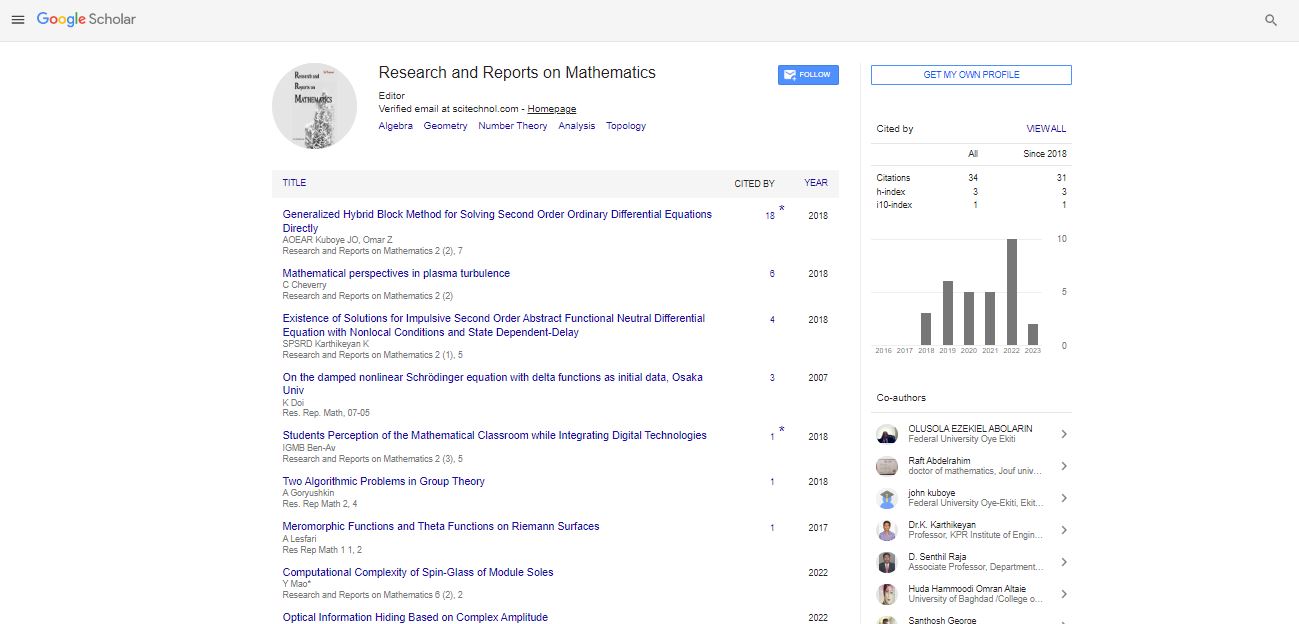Commentary, Res Rep Math Vol: 7 Issue: 5
Comprehensive Analysis of Set Theory in Modern Mathematics
Wiltod Mugeri*
1Department of Mathematics and Earth Sciences, University of Trieste, Trieste, Italy
*Corresponding Author: Wiltod Mugeri,
Department of Mathematics and Earth
Sciences, University of Trieste, Trieste, Italy
E-mail: mugeriwil@units.it
Received date: 27 November, 2023, Manuscript No. RRM-24-124960;
Editor assigned date: 29 November, 2023, Pre QC No. RRM-24-124960 (PQ);
Reviewed date: 14 December, 2023, QC No.RRM-24-124960;
Revised date: 21 December, 2023, Manuscript No.RRM-24-124960 (R);
Published date: 28 December, 2023, DOI: 07.4172/rrm.1000218
Citation: Mugeri W (2023) Comprehensive analysis of Set Theory in Modern Mathematics. Res Rep Math 7:5.
Description
Set theory, a branch of mathematical logic, serves as the bedrock upon which the entire edifice of modern mathematics is constructed. Originating in the late 19th century with the groundbreaking work of mathematicians like Georg Cantor, set theory provides a formal framework for the definition, manipulation, and study of sets collections of distinct objects. Set theory starts with the fundamental concept of a set an unordered collection of distinct elements. Sets are denoted by curly braces, and their elements are listed inside. Sets play a central role in mathematics as they provide a concise and abstract way to describe mathematical objects and relationships. Zermelo- Fraenkel set theory (ZF) and the Zermelo-Fraenkel set theory with the Axiom of Choice (ZFC) constitute the standard axiomatic systems for set theory. These axioms establish the rules and properties that sets must satisfy. The Axiom of Extensionality states that two sets are equal if and only if they have the same elements.
Other axioms address issues like the existence of empty sets, pairing sets, and the union and power set operations. Georg Cantor, often considered the founder of set theory, made groundbreaking contributions in the late 19th and early 20th centuries. He introduced the concept of cardinality to compare the sizes of sets, establishing a hierarchy of infinities. Cantor's work laid the groundwork for understanding the profound nature of infinite sets, revealing that some infinities are larger than others. The concept of cardinality measures the "size" or "number of elements" in a set. Two sets have the same cardinality if there exists a one-to-one correspondence (bijection) between their elements. Cantor introduced the notion of different infinities by demonstrating that the set of real numbers has a larger cardinality than the set of natural numbers. Ordinal numbers extend the idea of cardinality to well-ordered sets. They represent the order type of a well-ordered set, capturing the notion of "first," "second," and so on. The set of natural numbers, for instance, is associated with the ordinal number ω (omega). Ordinal arithmetic and the concept of transfinite induction are integral components of set theory. Set theory defines various operations to manipulate and combine sets.
Bertrand Russell's paradox, discovered in 1901, exposed a potential inconsistency in naive set theory. The paradox arises when considering the set of all sets that do not contain themselves. If such a set exists, it leads to a logical contradiction. This paradox prompted the development of more rigorous axiomatic set theories to address foundational issues. Georg Cantor, in the late 19th century, initiated the formalization of set theory by introducing the concept of sets and their cardinalities. His work on the infinite, transfinite numbers, and the continuum hypothesis laid the groundwork for the systematic study of sets and their properties. In response to foundational concerns raised by Russell's paradox, Ernst Zermelo formulated an axiomatic set theory in 1908. Zermelo's set theory, later refined by Abraham Fraenkel and others, addressed the issues of Russell's paradox and provided a solid foundation for modern set theory. The Axiom of Choice, introduced by Zermelo in 1904, asserts that for any collection of non-empty sets, there exists a function that selects one element from each set. While initially controversial, the Axiom of Choice was eventually embraced due to its utility in proving mathematical results. Together with Zermelo-Fraenkel set theory, it forms the basis of ZFC, the standard axiomatic system.
Applications of set theory
Set theory forms the basis for mathematical logic, providing the framework for formalizing mathematical reasoning and proofs. Propositional and predicate logic, model theory, and proof theory all rely on set-theoretic concepts to establish the foundations of rigorous mathematical reasoning. Set theory plays a central role in topology, a branch of mathematics that studies the properties of space that are preserved under continuous deformations. Concepts such as open and closed sets, compactness, and continuity are defined using settheoretic language, providing a powerful tool for analyzing geometric structures.
The study of algebraic structures, including groups, rings, and fields, heavily relies on set theory. Sets serve as the underlying structure for defining these algebraic objects, and operations on sets provide the foundation for understanding algebraic operations. Set theory is fundamental to computer science, serving as the basis for data structures, algorithms, and the study of computational complexity. Sets and their operations are foundational in databases, programming languages, and the design of algorithms. Set theory provides the foundational framework for all of mathematics. By formalizing mathematical concepts in terms of sets and set operations, mathematicians ensure precision and rigor in their reasoning. The axioms of ZFC, in particular, establish the standard foundation for modern mathematics.
Conclusion
Set theory stands as the cornerstone of modern mathematics, providing a formal foundation for defining and manipulating sets. Originating in the late 19th century, the development of Zermelo- Fraenkel set theory with the Axiom of Choice (ZFC) addressed foundational challenges, ensuring the robustness of mathematical reasoning. Georg Cantor's groundbreaking contributions, including cardinality and transfinite numbers, laid the groundwork for understanding infinite sets. Set theory finds extensive applications in various mathematical disciplines, such as logic, topology, and algebra, while also serving as the basis for computer science. Challenges persist, notably the continuum hypothesis's independence from standard axioms, presenting ongoing research opportunities.
 Spanish
Spanish  Chinese
Chinese  Russian
Russian  German
German  French
French  Japanese
Japanese  Portuguese
Portuguese  Hindi
Hindi 